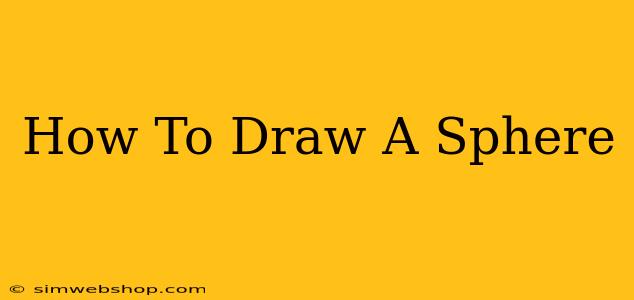Drawing a perfect sphere might seem daunting, but with the right techniques and a little practice, you can master this fundamental form in no time. This guide will walk you through various methods, from simple to more advanced, helping you achieve realistic and captivating spherical shapes in your artwork.
Understanding the Basics of Sphere Drawing
Before diving into techniques, it's crucial to understand the fundamental characteristics of a sphere:
- Three-Dimensional Form: A sphere is a three-dimensional object, meaning it possesses volume and depth. This needs to be conveyed in your drawing.
- Curvature: The consistent, smooth curvature is the defining feature. There are no straight lines on a sphere.
- Light and Shadow: Light interacts with a sphere's surface, creating highlights, midtones, and shadows that define its form and three-dimensionality. Mastering light and shadow is key to a believable sphere.
Method 1: The Simple Ellipse Method
This method is ideal for beginners. It provides a foundational understanding of perspective and form.
- Draw an Ellipse: Start by drawing a slightly elongated ellipse. This will form the base of your sphere. Think of it as looking at a circle from a slight angle.
- Add a Vertical Line: Draw a vertical line through the center of the ellipse. This line helps establish the sphere's central axis.
- Draw a Second Ellipse: Draw a smaller ellipse above the first, slightly overlapping. This will create the top of the sphere, suggesting its roundness.
- Connect the Ellipses: Gently connect the two ellipses, drawing smooth, curved lines. Avoid sharp corners. This step is about refining the form and smoothing the transition between the top and bottom ellipses.
- Erase Guidelines (Optional): Once you are satisfied with the shape, you can erase the initial guideline ellipses.
Method 2: Using Construction Lines for a More Precise Sphere
This method is slightly more complex but offers greater precision and control:
- Draw a Circle: Begin by drawing a circle as your base. This will be the front-most part of your sphere.
- Draw Guidelines: Draw two vertical lines tangent to the circle, extending slightly above and below. These lines will guide the upper and lower portions.
- Create the Top and Bottom: Sketch soft, curved lines from the top of the circle, following the vertical guide lines, to create the top of the sphere. Repeat for the bottom.
- Refine the Shape: Use gentle curves to connect the top and bottom sections, maintaining the spherical shape.
- Erase Guidelines: Erase the initial circle and guidelines once you are content with the overall form.
Mastering Light and Shadow on Your Sphere
Adding light and shadow is essential to making your sphere appear three-dimensional and realistic.
- Identify the Light Source: Determine the direction of your light source (e.g., from above, to the side).
- Highlight: Place a small, bright highlight where the light directly hits the sphere.
- Midtones: Gradually shade the areas around the highlight, creating a smooth transition to the shadow.
- Core Shadow: Create a darker, more defined shadow on the opposite side of the highlight. This is the area furthest from the light source.
- Reflected Light: Add a subtle, lighter area within the core shadow. This is where light bounces back from the surrounding environment.
- Cast Shadow: Consider adding a cast shadow—the shadow the sphere projects onto the surface below—to enhance the three-dimensionality.
Practice Makes Perfect
Drawing spheres takes practice. Don't be discouraged if your first attempts aren't perfect. The more you practice, the better you'll become at understanding and replicating its form and capturing the interplay of light and shadow. Experiment with different methods and lighting conditions to expand your skills.

